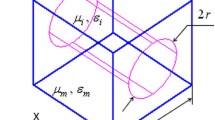Abstract
In this paper, the determination of electric permittivity and magnetic permeability of a dielectric metamaterial composed of an infinite number of conductors (split ring resonators) using the quasi-static Lorentz theory is investigated. The induced currents on the conductors are calculated with the method of moments. Negative values of the real parts of the permittivity and permeability are obtained within a given frequency band. Various modifications to the original configuration are made and their effects on the behavior of both permittivity and permeability are discussed. The obtained results are in good satisfactory with the theory predicting the possibility to have negative values of the considered parameters as well as the numerous reported works.




















Similar content being viewed by others
References
Veselago, V. G. (1968). The electrodynamics of substances with simultaneously negative values of ε and μ. Sov Phys Usp, 10(4), 509–514.
Pendry, J. B., Holden, A. J., Stewart, W. J., et al. (1996). Extremely low frequency plasmons in metallic mesostructures. Phys Rev Lett, 76, 4773–4776.
Pendry, J. B., Holden, A. J., Obbins, D. J., et al. (1999). Magnetism from conductors and enhanced nonlinear phenomena. IEEE Trans Microw Theory Tech, 47, 2075–2084.
Smith, D. R., & Liu, R. (2010). Metamaterials: theory, design and applications. New York: Springer.
Ishimaru, A. (2003). Generalized constitutive relations for metamaterials based on the quasi-static Lorentz theory. IEEE Trans Antennas Propag, 51(10), 2550–2557.
Orfanidis, S. J. (2010). Electromagnetic waves and antennas. Piscataway: Rutgers University.
Collin, R. E. (1990). Field theory of guided waves. New York: Wiley-IEEE Press.
Harrington, R. F. (1967). Matrix methods for field problems. Proc IEEE, 55(2), 136–149.
Author information
Authors and Affiliations
Corresponding author
Rights and permissions
About this article
Cite this article
Semmar, B., Aksas, R., Challal, M. et al. Numerical Determination of Permittivity and Permeability Tensors of a Dielectric Metamaterial Composed of an Infinite Number of Split Ring Resonators. Wireless Pers Commun 83, 2925–2947 (2015). https://doi.org/10.1007/s11277-015-2574-0
Published:
Issue Date:
DOI: https://doi.org/10.1007/s11277-015-2574-0



